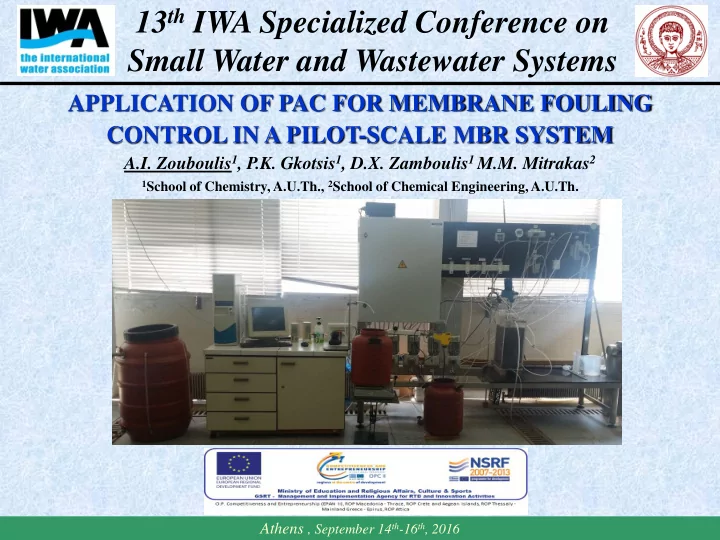

13 th IWA Specialized Conference on Small Water and Wastewater Systems APPLICATION OF PAC FOR MEMBRANE FOULING CONTROL IN A PILOT-SCALE MBR SYSTEM A.I. Zouboulis 1 , P.K. Gkotsis 1 , D.X. Zamboulis 1 M.M. Mitrakas 2 1 School of Chemistry, A.U.Th., 2 School of Chemical Engineering, A.U.Th. Athens , September 14 th -16 th , 2016
Membrane Bioreactor (MBR) technology Wastewater treatment & water reclamation through the integration of biological wastewater treatment with membrane technology 2 Submerged/Immersed MBR Side-stream/External MBR
Membrane fouling FOULING A process by which a variety of species present in the water increase the membrane resistance by: (1) adsorption onto the pore surfaces within the bulk membrane material (pore restriction) (2) complete pore-blocking (3) deposition onto its surface
Common methods applied for fouling mitigation A. Optimal operation of MBR process B. Physical cleaning 1. Permeate flux reduction 1.Filtration breaks 2. Aeration increase Periodical discontinuity of filtration (e.g. - Gas/liquid flow to achieve shear stress at the surface every 10 min for 1 min) - Partly intermittent & coupled with filtration breaks 2. Backflushing Periodically with permeate (e.g. every 3- 10 min for 15-60 s) C. Chemical cleaning (NaClO, C 6 H 8 O 7 etc)
Innovative methods applied for fouling mitigation A. Adsorbent agents B. Coagulant addition activated carbon, zeolite e.t.c. FeCl 3 , Al 2 (SO 4 ) 3 , PACl, (reduced cake resistance) cationic organic polymers e.t.c. (larger aggregates of the biological flocs) Conner et al. (2011) C. Quorum quenching (QQ) • Communication by signaling molecules (autoinducers) & regulation of gene expression • Controlling bacteria (inhibition of QQ) by interfering with their signalling systems
Innovative methods applied for fouling mitigation D. Application of ultrasound, electric field and ozone E. Membrane surface modification 1. Physical coating/adsorption on the membrane surface Hu et al. (2010) (i) Coating via filtration (ii) Coating via adsorption (iii) Coating via casting 2. Grafting methods on the membrane surface 3. Patterned membranes 4. Plasma treatment of polymer membranes 5. Chemical reactions on the membrane surface 6. Surface modifications with nanoparticles (i) Membrane modification with deposited nanoparticles (ii) Phase inversion method Maruf et al. (2014)
Primary objective PRIMARY OBJECTIVE The development of an integrated methodology for fouling control in MBRs by the: ! Addition of powdered activated carbon (PAC) that will improve sludge filterability and promote the removal (adsorption) of organics which are responsible for fouling
Pilot-scale MBR system DO MFM EB PG FI B PT WT WT WT: Wastewater Tanks EB: Electronic Board B: Bioreactor FI: Flow Indicators PT: Permeate Tank PG: Pressure Gauge DO: Dissolved Oxygen meter MFM: Mass Flow Meter
Pilot-scale MBR system
Pilot-scale MBR system PLC
Synthetic municipal wastewater Synthetic wastewater composition Substance Concentration (g/L) Peptone water 1.60 Meat extract 1.10 Urea 0.30 K 2 HPO 4 0.28 NaCl 0.07 CaCl 2 ∙2H 2 O 0.04 MgSO 4 ∙7H 2 O 0.02 Synthetic wastewater characterization Low Medium High strength strength strength • BOD = 1036 ± 58 mg/L COD, 250 500 1000 mg/L • COD = 1987 ± 73 mg/L BOD, 110 220 400 • mg/L SS = 0 mg/L • (Tchobanoglous, 1991) pH = 7.3
Membrane characteristics & pilot-scale MBR operation Kubota FS membrane, H-203 Membrane specifications Model H-203 Configuration Flat Sheet Material Chlorinated Polyethylene 0.4 μ m Pore size 0.11 m 2 Surface area Maximum TMP 20 kPa (0.2 bar) Chemical cleaning Citric or oxalic acid Operating parameters • Filtration time: 9 min • Backwashing time: 1 min • DO: 2-3 mg/L • Flux: 17 LMH • F/M: 0.2 mg BOD / (mg MLVSS ∙ d) • HRT: 13 h • SRT: 10 d
Bench-scale experiments Ability to test a wide range of PAC concentrations (0.5 - 5.0 g/L) A. Filterability tests (reversible fouling) Time to filter (TTF) test method (APHA 1992) P = 510 mbar V filt = 50 mL B. SMP (sEPS) concentration measurements (irreversible fouling) Phenol-Sulphuric (colorimetric) Acid Method (carbohydrate concentration determination)
Results - Effect on reversible fouling no PAC no PAC PAC PAC Addition of PAC at 0.5 g/L Addition of PAC at 1.0 g/L no PAC no PAC PAC PAC Addition of PAC at 1.5 g/L Addition of PAC at 2.0 g/L
Results - Effect on reversible fouling no PAC no PAC PAC PAC Addition of PAC at 3.0 g/L Addition of PAC at 2.5 g/L no PAC no PAC PAC PAC Addition of PAC at 3.5 g/L Addition of PAC at 4.0 g/L
Results - Effect on reversible fouling no PAC no PAC PAC PAC Addition of PAC at 4.5 g/L Addition of PAC at 5.0 g/L no PAC • The addition of PAC enhanced sludge PAC filterability at all concentrations • Optimal concentration in the mixed liquor : 3.0 g/L
Results - Effect on irreversible fouling & comparison Optimal concentration Optimal conditions
Results - MBR operation and removal efficiency
Conclusions A) Membrane fouling assessment The addition of PAC enhanced sludge filterability at all concentrations (0.5 - 5.0 g/L) Optimal concentration in the mixed liquor regarding both reversible and irreversible fouling mitigation: 3.0 g/L Strong indication that PAC might act as a foulant at high concentrations (> 5 g/L) B) MBR operation & removal efficiency The pilot-scale MBR operated successfully with a challengingly high strength synthetic municipal wastewater Remarkable behaviour was observed in terms of organic removal (> 95%).
13 th IWA Specialized Conference on Small Water and Wastewater Systems THANK NK YOU VE VERY Y MUCH CH Acknowledgements The financial support through the co-financing by: a) The European Union and the Greek State Program EPAN-II (OPCII)/ ESPA (NSRF): 'SYNERGASIA II', Project (FOULMEM) "New processes for fouling control in membrane bioreactors” (11SYN 8-1084) and b) The European Union and the Greek State Program PAVET, Project (PhoReSE): ‘‘Recovery of Phosphorus from the Secondary Effluent of Municipal Wastewater Treatment’’ and the active participation of ‘‘Aktor’’ S.A. company, are gratefully appreciated. The latter was supported also by the EYATh’s S.A. (Thessaloniki Water Supply and Sewerage Co.) - Department of Plants' Operation, Maintenance and Environmental Monitoring, which is gratefully appreciated.
Recommend
More recommend